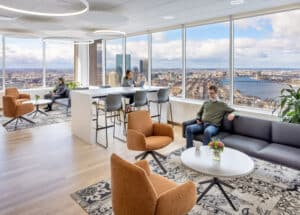
Margulies Perruzzi redesigned the offices of investment management firm Boston Trust Walden, on the 34th floor of Boston’s One Beacon tower, to reflect the company’s new way of working. Photo by Warren Patterson | Courtesy of Margulies Perruzzi
During the early days of the pandemic, we collectively embraced the notion that once vaccines became available, things would return to a “new normal,” and a mass return to the office would follow.
In reality, the hybrid work environment – long a staple in certain high-tech industries and made possible through advancements in technology – was mainstreamed. At the time, Margulies Perruzzi’s workplace strategy report, “Embracing the Hybrid Workspace,” affirmed the logic of transitioning from a traditional to hybrid model.
Our survey of 8,600 people across multiple business sectors revealed that 44 percent of workers planned on being in the office three days a week, and 25 percent planned on two days. Only 9 percent responded that they would return to a pre-pandemic office presence.
A Buzzword Is Back
It seems appropriate to resurrect a late-1990s buzzword, “paradigm shift,” because the pandemic is almost solely responsible for a fundamental change in the basic concepts and practices related to the traditional, corporate 9-to-5 in-office model.
Corporate managers who make real estate and facility decisions are facing the new reality of altered employee expectations. We know of one company that had an epiphany when they realized that the 100,000-square-foot building they own sits mostly empty, because in their new hybrid work environment, they have never had more than 50 people show up to work in the office on any given day.
So where are we now, and what does the future look like?
According to JLL’s third-quarter U.S. office outlook report, return-to-office metrics have trended upward this year, with most Fortune 500 employers gravitating to around three or more days of in-office attendance and pivoting away from fully remote hiring.
CBRE reported in their September office occupier sentiment survey that in the U.S., 65 percent of companies have a formal attendance requirement in place versus 31 percent one year ago. The average weekly office utilization rate varies by region; in the Asia-Pacific region 45 percent of respondents report their spaces to be highly utilized, while in the U.S. that figure is only 24 percent.
Many Look to Alter Spaces
We recently launched a new initiative to find out how our clients are approaching hybrid work, and the results align with what other industry leaders are reporting.
Sixty-three percent of our clients said had no formal hybrid or flexible attendance plan prior to the COVID-19 pandemic. However, 70 percent have one in place now.
Only 40 percent of our clients required attendance in the office a specific number of days per week, while 60 percent had “suggested” in-office targets. Meanwhile, 40 percent of our clients said they were an “office first” organization, with 20 percent identifying as “remote first” and the remainder saying they had a “true hybrid” character.
And while only 40 percent of our clients said they had reduced their office footprint, half said they had altered their office space in some way.
Occupiers’ Options Abound
There are many options available for implementing a full or partial return to the office, but there is no “one size fits all” solution. For the company I mentioned with a 100,000-square-foot, underutilized building, alternatives included selling it, relocating to a smaller space and designing it for how their staff works now, subletting half the square footage and redesigning the space they occupy, or keeping the building and initiating a mandatory in-office schedule.

Janet Morra
Companies opting to redesign current or new space to bring workers back to the office are using various tactics. Creating a more home-like atmosphere might translate into softer seating and less dependence on fixed workstations. Now that virtual meetings are routine, private offices can be transformed into huddle rooms where one or two people can conduct an online session with acoustic and visual privacy. There is also a move towards even more collaboration and team space, as well as organized events, activities and amenities designed to appeal to the basic human need to be together.
Sometimes the reconfiguration or downsizing of space boils down to pure math: If a company requires everyone to come in three days a week on the same days, then there is no option to reduce seating or decrease space. The only way this type of hybrid policy would work is if attendance is staggered throughout the week, and it is easy to imagine how quickly this could become complicated and counterproductive.
In the end, the most successful solution is one that is uniquely tailored to a company’s business model, strategic plan and corporate culture. Ultimately, flexibility of both thought and design are the keys to cultivating a successful hybrid work environment.
Janet Morra is a principal and partner at Boston architectural firm Margulies Perruzzi.




 |
| 
